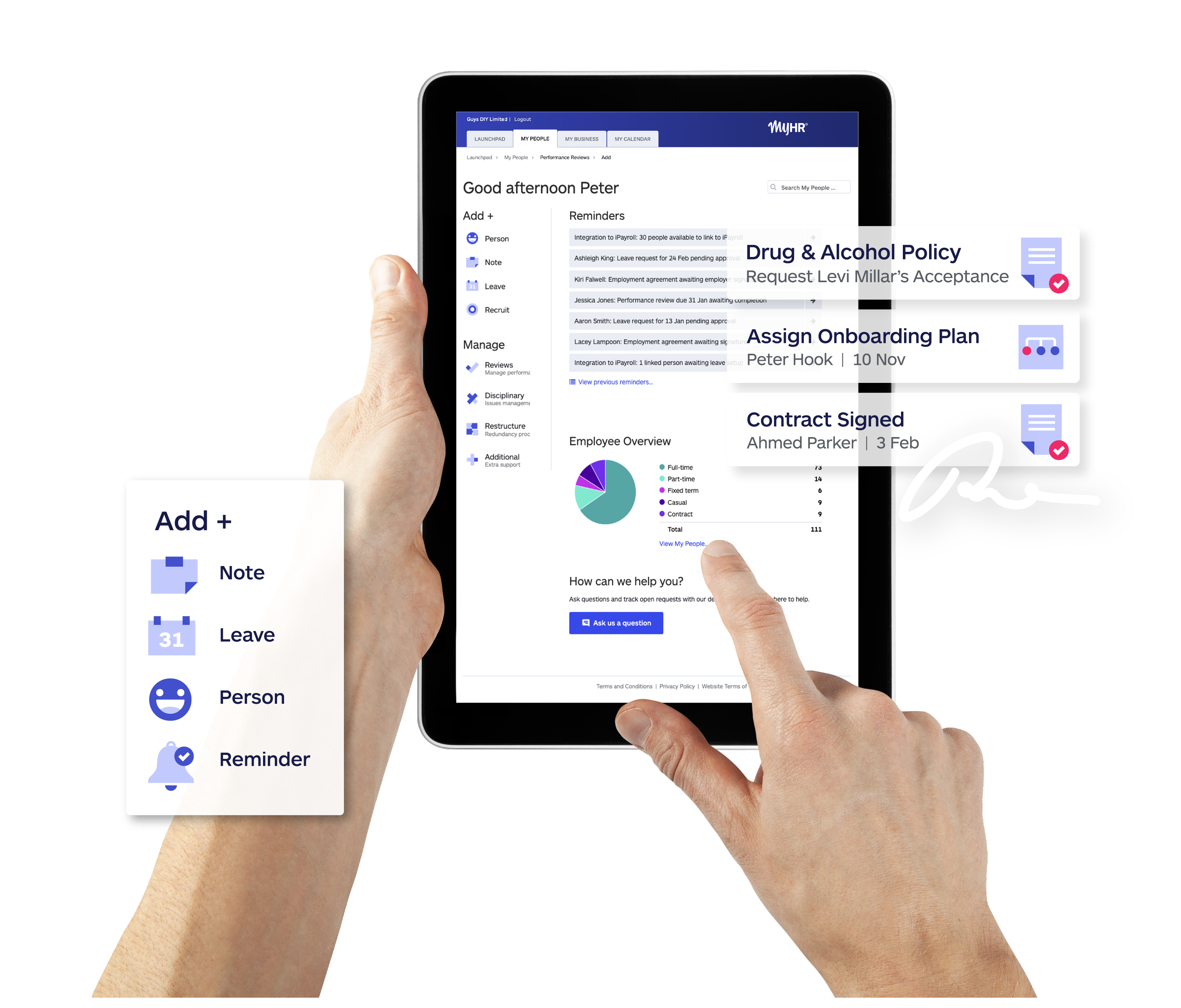Nothing says “Welcome to the company, we're stoked you're joining us” like a good onboarding process.
Even before you start recruiting for a position, you should be planning the way you make your new employees introduction to the business as smooth and comprehensive as possible.
Onboarding takes time and effort, but like all good investments, the rewards are worth it. Let's look at some of the main reasons you should have a thorough onboarding process for all new employees.
What is onboarding?
Onboarding is sometimes called induction, though it’s broader in scope than a simple initiation. Formally, onboarding is known as organisational socialisation, which means it's a structured process to provide a new person with all the tools, information, and insight they need to quickly become an effective team member, while at the same time integrating them with the company and its culture.
Sure, you could set them up with a desk and a computer, give them the company handbook, and tell them to get cracking on some initial tasks, but don't expect great results. The first few weeks of a new employee’s job can feel daunting and unfamiliar, so you don’t want to create more confusion or overwhelm them by not putting some effort into the onboarding process.
Effective onboarding helps your new team member hit the ground running. It gets the employment relationship off to a healthy start, and increases the chances that they'll want to stick with you and you'll want them around so they can develop with the business.
So why is employee onboarding so important?
Gets new employees up to speed faster
Few people have all the skills and knowledge they need to do an amazing job on the first day they show up for work. There can be a lot to learn, from simple things like getting acquainted with the building and the company IT system to understanding the demands and intricacies of the job itself.
Effective onboarding helps new employees become productive members of the team in the shortest time possible. It's all about using a structured approach to fully prepare an employee for their position and to support them as they grow into it.
It's in everyone's best interests to fast-track this bedding-in process. For the business, it means any disruption or dip in productivity is minimised and managers don't have to spend long hours training and orienting the new team member.
For the employee, it makes them feel part of an inclusive team that wants them to excel. They will clearly understand what is expected of them and what they have to do to meet those goals. They will feel good about the decision to take the job and the company they’ve joined, which sets everybody up for long-term success.
The last thing you want is a new employee dragging their heels and not contributing because they didn't understand expectations or didn’t get the right direction and support upfront.
Find out how MyHR's platform makes onboarding easier and more effective.
Employees are more engaged, with higher job satisfaction
Like in any relationship, first impressions count. New employees want to feel valued and supported, and taking the time to ensure they get off to a great start clearly demonstrates that they matter.
Successful onboarding boosts confidence and can play a big part in a worker's job satisfaction, and their ongoing commitment and loyalty to the organisation.
It also gives employers and managers the opportunity to establish rapport with the new employee, learning about their strengths, motivations, and aspirations. If the employment relationship is based on understanding and trust from the start, the better the outcomes for the employee and the business.
Better staff retention
Research has proven that the first days and months of a new worker's experience are vital to employee retention.
A recent study by research and analyst firm, Brandon Hall Group, found organisations with strong onboarding processes are up to 103% more likely to see improvements in key metrics like new hire retention and employee engagement.
These findings are backed up by the results of a study published in the Academy of Management Journal that found new employees who didn't get adequate support and direction in the first 90 days were unlikely to last much longer than 4 months in the job.
Keeping your staff turnover rate low saves time and money in the long run. Frequently hiring new people is expensive and time-consuming. So there is good reason to view onboarding as the start of a process to work with your employee to keep them happy and motivated, and make it less likely that they will look elsewhere.
Understand why employee retention is so important for your business.
Employees understand company culture and goals from day one
The first few weeks are the perfect time to introduce new employees to the values, priorities, culture, and mission of the company.
Again, it's about creating a positive impression. Chances are, your new employee will know about the company from the outside, but the first days on the job are their first exposure to how it works and feels on the inside.
A proper onboarding process can help the new employee establish themselves as part of the team while showing them how their role contributes to the organisation's wider goals. It's not just about learning about the company and its culture, but connecting to it and your existing staff.
Done well, your new team member will be more engaged and want to help the company succeed.
The company culture piece of the employee induction often contains these components:
- Company history - an overview of how the organisation came to be.
- Mission, vision, and values - the “why” of the business.
- Culture - what the employee experience is at the business.
- Business priorities and high-level goals - where the organisation is going, and how it will it get there.
- Organisational structure - what the organisational hierarchy is and the reporting structure.
Supports good hiring decisions and quick recovery from poor ones
A solid onboarding process can help employers and new workers decide if the person or the job matches their expectations. It's in everyone's best interest for this to happen quickly, so everyone can move on.
When the person is right for the position, effective onboarding provides a positive introduction to the business. On the rare occasions things go wrong, a good onboarding process will help you identify the bad eggs quickly and allow you to exit them in a robust manner, with less risk.
In the Australian context, onboarding is important to support good decision-making if your business utilises probation periods to assess new employees.
Under the Fair Work Act, employers are protected from claims of unfair dismissal by an employee during the probation period. Having a properly structured and managed onboarding and probation process will allow you to assess new hires and deal with those who don’t work out in a way that will withstand scrutiny.
Sets a base for further learning and development
In the modern work environment, employees need to be adaptable and learn new skills. While the learning curve is often steepest at the start of a new role, people thrive at companies that provide ongoing opportunities to learn and develop.
The initial job training that forms part of the onboarding process lays a good foundation that should lead to a course of growth and improvement.
It's a good time to find out about your new worker’s career goals and to design a training and development plan that builds their skills and knowledge. This will also help ensure they are motivated by, and contributing to, the overall success of the business.
A good onboarding process is less stressful - for everyone!
Starting a new job can be stressful. Sure, there's excitement in new opportunities but they can also create anxiety.
A smooth onboarding process can allay fears and make new people feel comfortable from day one, giving them the information and training they need to be able to concentrate on their job rather than any negative feelings.
Having an established, effective onboarding process reduces stress for employers and managers too, so you're not winging it each time you hire a new person. Instead, you can be confident that your new worker is getting the best possible orientation, guidance, and tools, so you can focus on assisting and getting to know them.
Customer satisfaction stays high
Studies show that positive employee experience leads to better customer experience, which improves business profitability.
Research by Jacob Morgan, author of The Employee Experience Advantage, found that companies that invest in employee experience are 4 times more profitable and generate twice as much revenue as those that don't.
The employee experience starts with recruitment and is expanded by the onboarding process, which should train employees as quickly as possible so there is minimal effect on the company and its customers.
If the process also inspires and motivates new team members, giving them a sense that the company is place where they want (not just need) to work, they will want to see it succeed and to provide the best possible service to your customers.
Get your employee induction and onboarding checklist
Our employee induction and onboarding checklist covers the 4 stages of onboarding: before the new person starts (because good onboarding starts as soon as the job offer is made), their first day on the job, the end of the first week, and regular review meetings during the first 3 months.
This checklist can be customised to your organisation’s environment, the role, and the needs of each new hire so they have their own unique onboarding plan.
-1.jpg)



